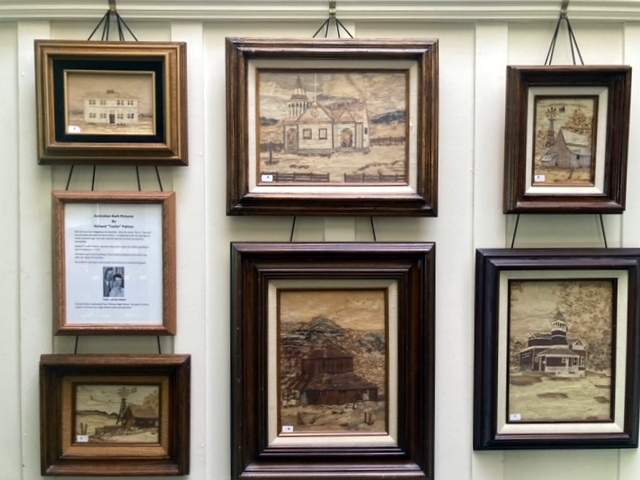|
History of Toolie and Bank Art
 Above is the display of some of Toolie Palmer’s work at the Fillmore Historical Museum today. Photo credit Fillmore Historical Museum. By Gazette Staff Writers — Thursday, November 16th, 2023
Above is Richard and Kay “Toolie” Palmer. Photo credit Fillmore Historical Museum. Courtesy Fillmore Historical Museum There’s a new exhibit at the Museum. In it you will see images of some historical buildings in the area such as the Santa Clara (Little Red) School House, the Arundell Adobe, and even the Museum’s own Rancho Sespe Bunkhouse #2. But what you are looking at isn’t a photograph or a painting. It’s bark art. Now some folks reading this already know what we are referring to, but to the uninitiated, bark art is an Australian Aboriginal art form, involving painting on the interior of a strip of tree bark. In some forms no paint is used, but instead the colors are achieved by the careful use of fire. So why does the Fillmore Historical Museum have a small collection of Bark Art? Toolie Palmer is the answer to that question. Richard “Toolie” Palmer was born in Fillmore in 1915 to George and Cecilia Buena Ventura “Tulip” Middleswarth Palmer. Richard received his nickname of “Toolie” because he was Tulip’s son. George was a barber in Fillmore as well as being fire chief. Toolie attended Fillmore High School where he was a standout athlete. He set a school record in pole vault. In basketball he was the most valuable Class “B” player in both his junior and senior years and as captain, led Fillmore to victory in the Class “B” CIF Championship. He received his bachelor’s of arts degree in physical education from Santa Barbara State and a Master’s in education from USC. In 1947, Toolie returned to Fillmore where he took over the duties of athletic director, track and basketball head coach and assistant football coach. He was on the faculty of Fillmore High School for 22 years. In 1986 he received the Southern California Interscholastic Coaches’ Award for his service to Fillmore High School. In 1989 he was inducted into the Ventura County Sports Hall of Fame. In 1975 Toolie and his wife, Kay, visited their son, Richard, in Australia. They spent about a year down under and during that time Toolie became interested in the indigenous art form. The biggest hurdle Toolie had was finding the right bark. The traditional bark art “paintings” are made from the bark of the Australian “tea” or “swamp” tree (the scientific name is Melaleuca leauadendron). He finally found a source who would ship the bark to him at Fillmore. Eucalyptus is a possible substitute but would not have given a similar final product. In a 1980s interview with Janet Bergamo, Toolie said he had sold “1,200 paintings and has given away countless others to friend and former students from Fillmore High School.” The Fillmore Historical Museum has been fortunate to have been given a small number of Toolie’s work and now can share that with the community. |
